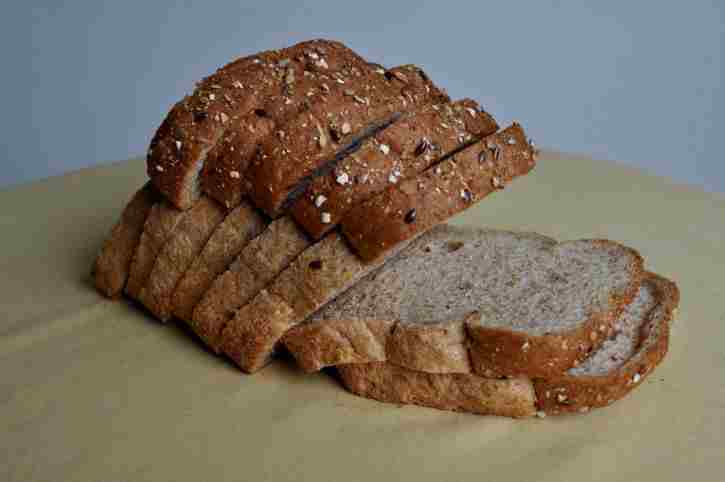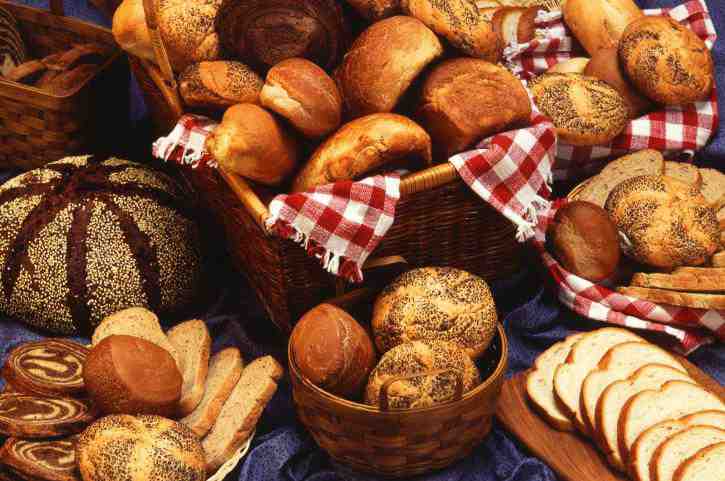How To Cook Bread - Primitive Skills - Survival Manual
How to make bread!
Let's make some bread. First let's take a look at the ingredients you will need. You will need yeast or natural starter that you can make a few days before hand, water, flour, sugar, salt, oil, pans, thermometer and an oven. This is what you will need for a basic loaf of bread. Other ingredients can be added and you make due with what you have. Some things are required like the flour but others are for taste.
 I am going to assume you don't have yeast packets available so the first step is getting a substitute for commercially available yeast. The good news is that doing it the old fashioned way will make your bread healthier and potentially longer lasting. To get your first ingredient, yeast, you will need to make what is called a starter. This process takes a few days so let's get right down to it.
I am going to assume you don't have yeast packets available so the first step is getting a substitute for commercially available yeast. The good news is that doing it the old fashioned way will make your bread healthier and potentially longer lasting. To get your first ingredient, yeast, you will need to make what is called a starter. This process takes a few days so let's get right down to it.
Place equal parts of flour and water in a bowl and mix together. place a piece of plastic wrap or whatever over the top of the bowl and let it just sit there. You don't want a tight fitting lid. Let it sit for 24 hours.
Now discard 1/2 of the mixture. Yes you read that right throw out 1/2. Now add more flour and water like you did the first day but this time half as much. And again allow it to sit for 24 hours. (at 80F/27C)
Repeat the above process for another 3 days. On day 6 you might be ready to go. the culture should have shown signs of rising and falling initially and then that should slow and the final product on day 5 should show bubbles forming in the starter.
Now continue with the regime but do it twice a day. Do this for a couple of days and Voila! You have your starter. Hopefully your starter will have had the undesirable yeast die off and the good yeast rapidly multiply.
You now have your starter and you can use it all up and start a new one the next time you want to bake bread or you can keep periodically feeding it and keep the culture alive and ready to go each time you want to bake bread.
To keep the starter alive you don't need to repeat the process as frequently and you don't need it to be as large. Just a small amount of starter can have the process kept at about day 6 and 7 of the process. This will allow you to very quickly have a starter in the future. It is quicker because you are already starting with the correct species of yeast. No need to wait for the undesirable yeast to die off.
Keep in mind that this regime is for 80F. Your local weather will dictate changes to the process. This is an art not a science. Through each cycle if you notice the starter getting more dense/falling and hardening a little towards the end of the cycle then you need to shorten your cycle. Your local yeast and weather can and will affect this process. Also, the starter will be best if used right at its maximum volume. Just before it deflates. The falling indicates that the yeast have eaten all of the nutrients and are now dying.
Also warm weather periods are the easiest times to get a starter going. So try to keep a starter going through the winter and not let it die off completely. Winter time is when microorganisms are at the lowest level of reproduction and activity which makes getting the yeast in your starter harder.
OK so that is the hardest part... trust me. Now that you have your starter you can begin to bake your bread. To do this you will need to take some of your starter and cultivate it so that it is enough for a loaf of bread.
 Scoop the starter into a bowl about 2.5 ounces. Pour an equal amount of water into the bowl and stir it in. Add an equal amount of flour in and again stir it in until it is smooth. Cover the bowl with a small plate or lid and let it sit overnight.
Scoop the starter into a bowl about 2.5 ounces. Pour an equal amount of water into the bowl and stir it in. Add an equal amount of flour in and again stir it in until it is smooth. Cover the bowl with a small plate or lid and let it sit overnight.
The amount of material you have let sit in the bowl overnight determines how much bread you can make. So for measurement sake let's say the bowl contains 1 unit of starter. Now add two units of water, three units of flour. Mix together and then let it sit for 30 minutes so the flour can absorb more water.
Now add two teaspoons of salt and knead for 6 to 10 minutes. Knead until the dough pulls away from the bowl and is somewhat shiny. Your flour will be different from mine so you need to sort of wing it and with time you will be able to refine the recipe to fit what works best for you. You may have to add water or you may have to add flour. Ideally you don't add either but first time you are likely to have to add a bit to get your dough just right.
Cover and let it sit for a couple of hours. Hopefully it will have started to rise even if just a little. Be patient and let it sit until it has almost doubled in size. Roughly 6 hours or more but that time depends on lots of factors so don't worry if you reach it a little sooner or later.
Pour a drop of neutral-flavored oil into the bread pot, add a good pinch of flour and rub this mixture along the bottom and sides of the pot. This will hopefully prevent the loaf from sticking to the pot.
Now remove the dough and place on a floured counter or stone and fold 3 times like you would fold a letter going into an envelope. Turn the dough sideways and repeat the 3 folds again.
If needed repeat this folding routine until you can pick up your dough without it tearing. Now lift and flip the dough into the pot for baking.
Score the top of the bread with a knife to form a cross. Place the lid on the pot and put the pot in your cold oven. Switch the oven on with a temperature setting of 450F and leave the bread in for about 1 hour until well risen and golden brown. Remove from the oven and remove the bread from the pot to cool.
Done! Congratulations. Wow you will never again look at lowly bread the same way again.
Let's make some bread. First let's take a look at the ingredients you will need. You will need yeast or natural starter that you can make a few days before hand, water, flour, sugar, salt, oil, pans, thermometer and an oven. This is what you will need for a basic loaf of bread. Other ingredients can be added and you make due with what you have. Some things are required like the flour but others are for taste.

Place equal parts of flour and water in a bowl and mix together. place a piece of plastic wrap or whatever over the top of the bowl and let it just sit there. You don't want a tight fitting lid. Let it sit for 24 hours.
Now discard 1/2 of the mixture. Yes you read that right throw out 1/2. Now add more flour and water like you did the first day but this time half as much. And again allow it to sit for 24 hours. (at 80F/27C)
Now continue with the regime but do it twice a day. Do this for a couple of days and Voila! You have your starter. Hopefully your starter will have had the undesirable yeast die off and the good yeast rapidly multiply.
You now have your starter and you can use it all up and start a new one the next time you want to bake bread or you can keep periodically feeding it and keep the culture alive and ready to go each time you want to bake bread.
To keep the starter alive you don't need to repeat the process as frequently and you don't need it to be as large. Just a small amount of starter can have the process kept at about day 6 and 7 of the process. This will allow you to very quickly have a starter in the future. It is quicker because you are already starting with the correct species of yeast. No need to wait for the undesirable yeast to die off.
Keep in mind that this regime is for 80F. Your local weather will dictate changes to the process. This is an art not a science. Through each cycle if you notice the starter getting more dense/falling and hardening a little towards the end of the cycle then you need to shorten your cycle. Your local yeast and weather can and will affect this process. Also, the starter will be best if used right at its maximum volume. Just before it deflates. The falling indicates that the yeast have eaten all of the nutrients and are now dying.
Also warm weather periods are the easiest times to get a starter going. So try to keep a starter going through the winter and not let it die off completely. Winter time is when microorganisms are at the lowest level of reproduction and activity which makes getting the yeast in your starter harder.
OK so that is the hardest part... trust me. Now that you have your starter you can begin to bake your bread. To do this you will need to take some of your starter and cultivate it so that it is enough for a loaf of bread.

The amount of material you have let sit in the bowl overnight determines how much bread you can make. So for measurement sake let's say the bowl contains 1 unit of starter. Now add two units of water, three units of flour. Mix together and then let it sit for 30 minutes so the flour can absorb more water.
Now add two teaspoons of salt and knead for 6 to 10 minutes. Knead until the dough pulls away from the bowl and is somewhat shiny. Your flour will be different from mine so you need to sort of wing it and with time you will be able to refine the recipe to fit what works best for you. You may have to add water or you may have to add flour. Ideally you don't add either but first time you are likely to have to add a bit to get your dough just right.
Cover and let it sit for a couple of hours. Hopefully it will have started to rise even if just a little. Be patient and let it sit until it has almost doubled in size. Roughly 6 hours or more but that time depends on lots of factors so don't worry if you reach it a little sooner or later.
Pour a drop of neutral-flavored oil into the bread pot, add a good pinch of flour and rub this mixture along the bottom and sides of the pot. This will hopefully prevent the loaf from sticking to the pot.
Now remove the dough and place on a floured counter or stone and fold 3 times like you would fold a letter going into an envelope. Turn the dough sideways and repeat the 3 folds again.
If needed repeat this folding routine until you can pick up your dough without it tearing. Now lift and flip the dough into the pot for baking.
Score the top of the bread with a knife to form a cross. Place the lid on the pot and put the pot in your cold oven. Switch the oven on with a temperature setting of 450F and leave the bread in for about 1 hour until well risen and golden brown. Remove from the oven and remove the bread from the pot to cool.
Done! Congratulations. Wow you will never again look at lowly bread the same way again.

